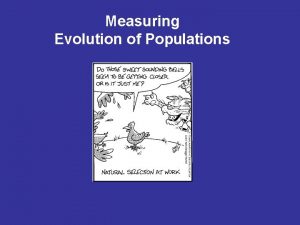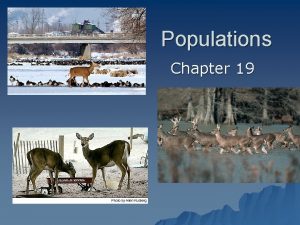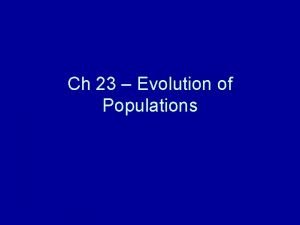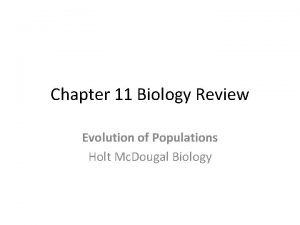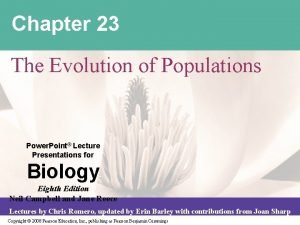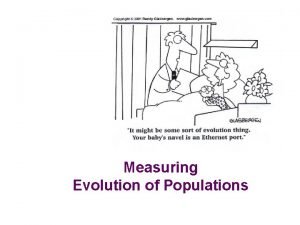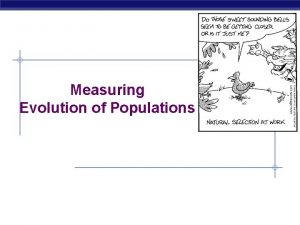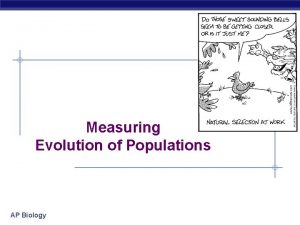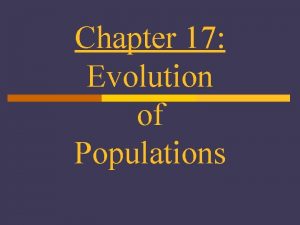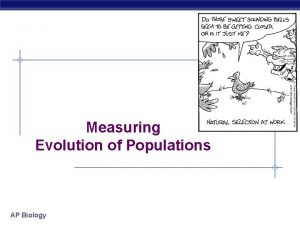Measuring Evolution of Populations 5 Agents of evolutionary











- Slides: 11

Measuring Evolution of Populations

5 Agents of evolutionary change Mutation Gene Flow Genetic Drift Non-random mating Natural Selection

Populations & Gene Pools Concepts • a population is a localized group of interbreeding individuals • a gene pool is a collection of alleles in the population • an allele frequency is how common is that allele in the population • how many A vs. a in whole population

Evolution of Populations Evolution = change in allele frequencies in a population • hypothetical: what conditions would cause allele frequencies to not change? • non-evolving population REMOVE all agents of evolutionary change 1. very large population size (no genetic drift) 2. no migration (no gene flow in or out) 3. no mutation (no genetic change) 4. random mating (no sexual selection) 5. no natural selection (everyone is equally fit)

Hardy-Weinberg equilibrium describes populations that are not evolving Real populations rarely meet all five conditions • Real population data is compared to a model • Models are used to studying how populations evolve

Hardy-Weinberg Equilibrium • Hypothetical, non-evolving population • preserves allele frequencies • Serves as a model (null hypothesis) • natural populations rarely in H-W equilibrium • useful model to measure if forces are acting on a population • Measuring evolutionary change G. H. Hardy mathematician W. Weinberg physician

The Hardy-Weinberg equation is used to predict genotype frequencies in a population Predicted genotype frequencies are compared with actual frequencies • used for traits in simple dominant-recessive systems • must know frequency of recessive homozygotes • p 2 + 2 pq + q 2 = 1 "The Hardy-Weinberg equation is based on Mendelian genetics. It is derived from a simple Punnett square in which p is the frequency of the dominant allele and q is the frequency of the recessive allele. "

Hardy-Weinberg Principle Counting Alleles • assume 2 alleles = B, b • frequency of dominant allele (B) = p • frequency of recessive allele (b) = q • frequencies must add to 1 (100%), so: p+q=1 BB Bb bb

Hardy-Weinberg Principle Counting Individuals • frequency of homozygous dominant: p x p = p 2 • frequency of homozygous recessive: q x q = q 2 • frequency of heterozygotes: (p x q) + (q x p) = 2 pq • frequencies of all individuals must add to 1 (100%), so: p 2 + 2 pq + q 2 = 1 BB Bb bb

H-W formulas Alleles: p+q=1 B Individuals: p 2 + 2 pq + q 2 = 1 BB BB b Bb Bb bb bb

Using Hardy-Weinberg equation population: 100 cats 84 black, 16 white How many of each genotype? p 2=. 36 BB q 2 (bb): 16/100 =. 16 q (b): √. 16 = 0. 4 p (B): 1 - 0. 4 = 0. 6 2 pq=. 48 Bb q 2=. 16 bb Must What assume are the population genotypeisfrequencies? in H-W equilibrium!
 Agent of evolutionary change
Agent of evolutionary change Sweet-sounding
Sweet-sounding Section 19-1 understanding populations answer key
Section 19-1 understanding populations answer key Evolution of populations section 16-1 genes and variation
Evolution of populations section 16-1 genes and variation Why are populations the smallest unit of evolution
Why are populations the smallest unit of evolution Chapter 16 evolution of populations vocabulary review
Chapter 16 evolution of populations vocabulary review Section 16-1 genes and variation
Section 16-1 genes and variation Chapter 17 evolution of populations answer key
Chapter 17 evolution of populations answer key Evolution of populations section 11 review
Evolution of populations section 11 review Chapter 23 the evolution of populations
Chapter 23 the evolution of populations Chapter 23 the evolution of populations
Chapter 23 the evolution of populations Stabilizing selection human birth weight
Stabilizing selection human birth weight

